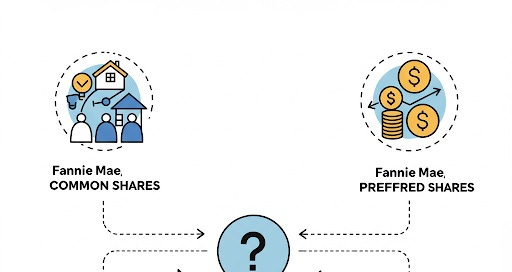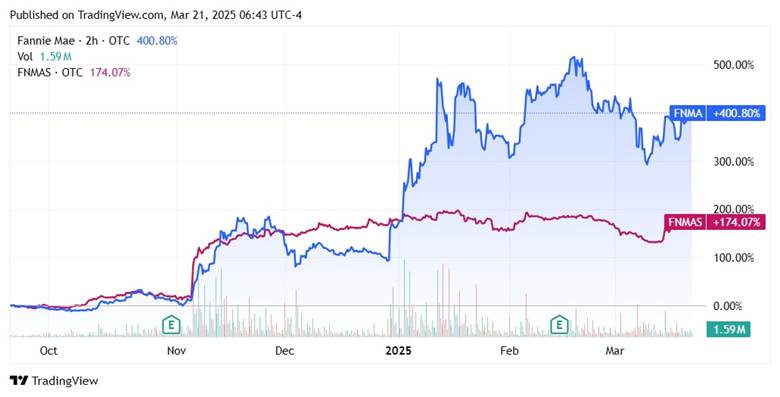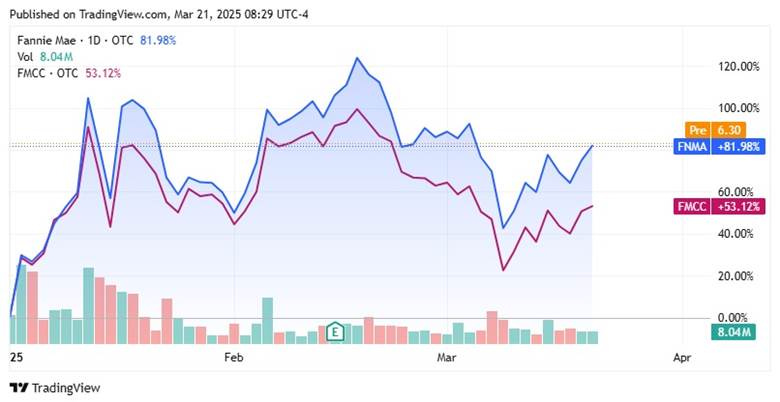Overview
Bill Ackman, CEO of Pershing Square Capital Management, made a compelling case for investing in the common shares of Fannie Mae (FNMA) and Freddie Mac (FMCC) , collectively referred to as "F2." His thesis elaborated in “The Art of the Deal” presentation (January 16, 2025) centers on their potential release from government conservatorship under the Trump administration, which could generate substantial returns for common shareholders.
Key Arguments for Common Shares Over Preferred Shares
1. Government's Position is Already Satisfied
Ackman emphasizes that the Senior Preferred Stock (SPS) held by the government has already been fully compensated:
The government has received $301 billion in payments, which is $25 billion more than contractually required
This excess payment occurred over five years ago, effectively retiring the SPS with interest plus an overpayment.
2. Alignment with Government Interests
The government's economic interests are actually aligned with common shareholders:
Treasury holds penny warrants on 79.9% of the common stock of both companies
By forgiving the SPS liability, the government immediately recovers 79.9 cents of every "forgiven" dollar through increased warrant value
The $25 billion overpayment to date more than compensates for any "leakage" to public shareholders (21.1%)
3. Higher Upside Potential
Common shares offer significantly higher upside compared to preferred shares:
Ackman projects share prices could reach approximately $35 for Fannie Mae by 2026 and $39 for Freddie Mac by 2027
This represents potential returns of ~650% for Fannie Mae and 780% for Freddie Mac from current prices
These projections are based on mid-teens P/E multiples, benchmarked against property/casualty insurers and utilities
4. Strategic Value to the Administration
Ackman believes the Trump administration has strong incentives to respect common shareholders:
President Trump has previously committed to F2's release from conservatorship in a 2021 public letter
F2 common stock is held by "many millions of retail and institutional investors who are Donald Trump supporters"
The administration benefits politically from creating value for these constituents
5. Sovereign Wealth Fund Potential
Ackman highlights Secretary Bessent's idea of making F2 core assets of a U.S. sovereign wealth fund:
F2 represents a "royalty on first mortgages secured by the US housing market"
This provides a low-risk, high risk-adjusted return investment
Will generate large and growing dividends that can be invested in other sovereign fund assets
Long-term returns will significantly exceed the cost of U.S. Treasurys, enabling national deleveraging
Government divestment over a period of five years or so becomes less likely
The Path to Privatization
Ackman outlines a credible framework for F2's exit from conservatorship:
Capital Requirements: Reduce equity capital requirement to 2.5% from 4%, aligning with F2's low-risk profile
Restructuring: Clean up existing capital structure by treating Treasury's senior preferred stock as repaid
New Private Capital Raises: Conduct "Re-IPOs" with Fannie Mae raising ~$5 billion by end-2026 and Freddie Mac ~$15 billion by end-2027
Government Stake Monetization: Treasury sells its 79.9% warrants over five years post-IPO, potentially generating over $300 billion
Preferred vs Common – Recent Performance
Over the past six months, Fannie Mae’s common shares (FNMA) have significantly outperformed its preferred shares (FNMAS), delivering an impressive return of approximately 400% compared to FNMAS’s roughly 175%. This disparity likely reflects heightened investor optimism about FNMA’s potential exit from conservatorship, fueled by proposals like Bill Ackman’s January 2025 presentation, which projected substantial upside for common shares via an earlier IPO timeline. Meanwhile, FNMAS, tied to a more capped payout structure, has seen steadier but less explosive growth, appealing to those seeking stability amid the GSEs’ uncertain future.
FNMA vs FMCC – Why the price difference?
As of March 21, 2025, Freddie Mac (FMCC) common shares trade at roughly 80% of Fannie Mae (FNMA)’s price—for instance, if FNMA is at $6.21, FMCC might hover around $5.16. This discount appears to stem partly from market perceptions influenced by Bill Ackman’s January 16, 2025, presentation, where he outlined a roadmap for both GSEs to exit conservatorship. Ackman projected an IPO for FNMA by the end of 2026, with FMCC following a year later in 2027. This staggered timeline—FNMA exiting first—may have led investors to assign a higher near-term value to FNMA, anticipating earlier clarity and potential gains, while FMCC’s delayed release introduces additional uncertainty and depresses its relative price.
However, this discount might undervalue FMCC’s potential, making it an intriguing option for investors. Several factors suggest FMCC could be a sleeper hit:
Earnings Power: If FMCC achieves a 2.5% capital ratio (as Ackman proposes), its earnings power — projected at $10.3 billion annually by 2027 — could support a higher valuation, potentially aligning closer to or exceeding FNMA’s multiples over time.
Market Overreaction: The
~20% discount may reflect an overreaction to the one-year lag rather than FMCC’s fundamentals. Both GSEs share similar business models, guaranteeing loans, with comparable guarantee fees (~60-61 bps). FMCC’s delay doesn’t diminish its core profitability or role in the housing market, suggesting the current price gap could narrow as the exit process unfolds, especially if political momentum under a Trump administration accelerates both timelines.Risk-Reward Asymmetry: FMCC’s lower price offers a higher potential percentage gain if it reaches Ackman’s $33.77 IPO target (a 605% increase from $5) versus FNMA’s $31.81 (a 412% increase from $6.21). For risk-tolerant investors, this asymmetry could make FMCC the better bet, particularly if delays prove shorter than expected or if FMCC’s capital build progresses faster than anticipated.
While FMCC’s later conservatorship exit introduces some timing risk, its current undervaluation relative to FNMA - positions it as a compelling alternative. Investors betting on Ackman’s vision might find FMCC’s discount an opportunity to capitalize on market mispricing, assuming both GSEs successfully navigate privatization.
Disclosure on Personal Bias
As noted previously, I started a position in Fannie/Freddie in 2015 and have dabbled in both Common and Preferred Shares. As of a year ago, my mid-single-digit allocation was exclusively to Preferred Shares. Due to the price appreciation of the preferred shares compared to the rest of my portfolio, the allocation has grown to a high-teens percentage. Following Bill Ackman’s presentation (January 2025) and hints from Scott Bessent (Secretary of the Treasury) in the all-in-podcast (mid-March 2025), I shifted the allocation to be ~75% preferred and ~25% common.
Risks and Considerations
While the potential upside is substantial, investors should consider:
Political uncertainty despite favorable outlook under the Trump administration
Potential regulatory hurdles in implementing capital requirement changes
Market volatility and low liquidity in the stocks
Possibility of delays in the privatization timeline
Conclusion
Ackman makes a strong case that common shares of Fannie Mae and Freddie Mac represent an asymmetric investment opportunity with significant upside potential. His argument rests on the fact that the government has already been fully compensated for its bailout, holds substantial upside through warrants, and has political incentives to respect shareholder rights. With projected returns of 600-700% over the next few years and alignment with the administration's goals, common shares appear to offer compelling value compared to preferred shares for investors willing to accept the associated risks and potential volatility. Further, FMCC offers more value compared to FNMA.
Disclaimer:
The information provided in this post is for informational purposes only and does not constitute investment advice, financial advice, or a recommendation to buy, sell, or hold securities, including shares of Fannie Mae (FNMA) or Freddie Mac (FMCC). Investing in FNMA and FMCC common and preferred shares involves significant risks, including but not limited to market volatility, government control, legal uncertainties, and the potential for total loss of investment. Past performance is not indicative of future results. All projections, estimates, and opinions are based on publicly available data and assumptions that may not prove accurate, and actual outcomes may differ materially. Pershing Square Capital Management, L.P., and its affiliates hold investments in FNMA and FMCC and may adjust their positions at any time. Investors should conduct their own research, consider their financial situation and risk tolerance, and consult with a qualified financial advisor before making any investment decisions. The author and publisher disclaim any liability for losses or damages arising from the use of this information.






